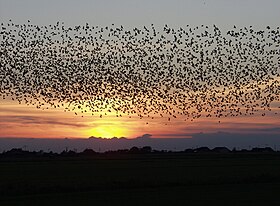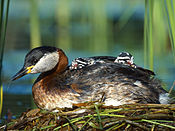List of Podicipediformes by population
| The population of birds |
|---|
 |
This is a list of Podicipediformes species by global population. While numbers are estimates, they have been made by the experts in their fields. For more information on how these estimates were ascertained, see Wikipedia's articles on population biology and population ecology.
This list is not comprehensive, as not all Podicipediformes have had their numbers quantified.
Species by global population[]
| Common name | Binomial name | Population | Status | Trend | Notes | Image |
|---|---|---|---|---|---|---|
| Junin grebe | Podiceps taczanowskii | 217- 304[1] | CR[1] | Endemic to Lake Junín, Peru.[1] | 
| |
| Hooded grebe | Podiceps gallardoi | 1000 – 1200[2] | CR[2] | Estimated at 3000 – 5000 in 1997.[2] | ||
| New Zealand grebe | Poliocephalus rufopectus | 1900 – 2000[3] | VU[3] | 
| ||
| Madagascar grebe | Tachybaptus pelzelnii | 5000[4] | VU[4] | Minimum estimate.[4] | 
| |
| Clark's grebe | Aechmophorus clarkii | 11 000 – 21 000[5] | LC[5] | 
| ||
| Western grebe | Aechmophorus occidentalis | 130 000[6] | LC[6] | 
| ||
| Horned grebe | Podiceps auritus | 140 000 – 1 100 000[7] | LC[7] | 
| ||
| Red-necked grebe | Podiceps grisegena | 190 000 – 290 000[8] | LC[8] | 
| ||
| Little grebe | Tachybaptus ruficollis | 610 000 – 3 500 000[9] | LC[9] | 
| ||
| Great crested grebe | Podiceps cristatus | 920 000 – 1 400 000[10] | LC[10] | Unknown[10] | 
| |
| Black-necked grebe | Podiceps nigricollis | 3 900 000 – 4 200 000[11] | LC[11] | Unknown[11] | 
|
See also[]
- Lists of birds by population
- Lists of organisms by population
References[]
- ^ a b c d BirdLife International (2020). "Podiceps taczanowskii". IUCN Red List of Threatened Species. 2020: e.T22696623A179685461. doi:10.2305/IUCN.UK.2020-3.RLTS.T22696623A179685461.en. Retrieved 12 November 2021.
- ^ a b c d BirdLife International (2019). "Podiceps gallardoi". IUCN Red List of Threatened Species. 2019: e.T22696628A145837361. doi:10.2305/IUCN.UK.2019-3.RLTS.T22696628A145837361.en. Retrieved 12 November 2021.
- ^ a b c BirdLife International (2016). "Poliocephalus rufopectus". IUCN Red List of Threatened Species. 2016: e.T22696592A93572730. doi:10.2305/IUCN.UK.2016-3.RLTS.T22696592A93572730.en. Retrieved 12 November 2021.
- ^ a b c d BirdLife International (2018). "Tachybaptus pelzelnii". IUCN Red List of Threatened Species. 2018: e.T22696565A131612478. doi:10.2305/IUCN.UK.2018-2.RLTS.T22696565A131612478.en. Retrieved 12 November 2021.
- ^ a b c BirdLife International (2016). "Aechmophorus clarkii". IUCN Red List of Threatened Species. 2016: e.T22696634A93575258. doi:10.2305/IUCN.UK.2016-3.RLTS.T22696634A93575258.en. Retrieved 12 November 2021.
- ^ a b c BirdLife International (2019). "Aechmophorus occidentalis". IUCN Red List of Threatened Species. 2019: e.T22696631A139355294. doi:10.2305/IUCN.UK.2019-3.RLTS.T22696631A139355294.en. Retrieved 12 November 2021.
- ^ a b c BirdLife International (2018). "Podiceps auritus". IUCN Red List of Threatened Species. 2018: e.T22696606A132066871. doi:10.2305/IUCN.UK.2018-2.RLTS.T22696606A132066871.en. Retrieved 12 November 2021.
- ^ a b c BirdLife International (2018). "Podiceps grisegena". IUCN Red List of Threatened Species. 2018: e.T22696599A132582688. doi:10.2305/IUCN.UK.2018-2.RLTS.T22696599A132582688.en. Retrieved 12 November 2021.
- ^ a b c BirdLife International (2019). "Tachybaptus ruficollis". IUCN Red List of Threatened Species. 2019: e.T22696545A155540155. doi:10.2305/IUCN.UK.2019-3.RLTS.T22696545A155540155.en. Retrieved 12 November 2021.
- ^ a b c BirdLife International (2019). "Podiceps cristatus". IUCN Red List of Threatened Species. 2019: e.T22696602A154250080. doi:10.2305/IUCN.UK.2019-3.RLTS.T22696602A154250080.en. Retrieved 12 November 2021.
- ^ a b c BirdLife International (2018). "Podiceps nigricollis". IUCN Red List of Threatened Species. 2018: e.T22696610A132584321. doi:10.2305/IUCN.UK.2018-2.RLTS.T22696610A132584321.en. Retrieved 12 November 2021.
Categories:
- Biology-related lists
- Lists of birds by population
